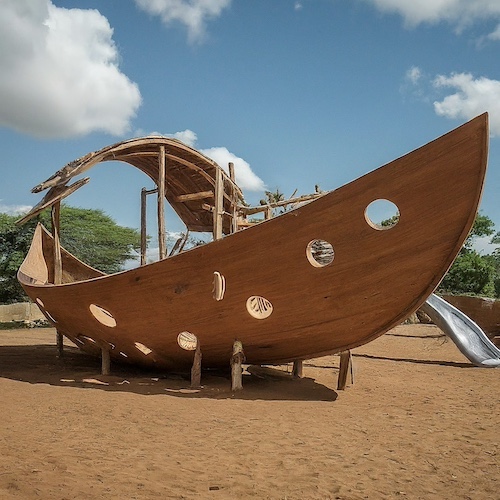Biomimicry Boat Playgrounds for Malawi
Biomimicry Boat Playgrounds: Setting Sail on Imagination in Malawi
Imagine a playground where children can climb, slide, and swing, all while celebrating Malawi's rich fishing and sailing heritage. Biomimicry Boat Playgrounds achieve just that, using recycled materials and clever designs to inspire a love for the water and the environment.
Plan and Types of Recycled Materials:
Focus on Durability: Choose recycled materials that can withstand Malawi's climate. Consider using:
Treated Lumber: Recycled wooden pallets or scrap construction timber can be treated for outdoor use and used for structural elements.
Durable Plastics: Recycled plastic bottles or packaging can be transformed into colourful climbing holds or decorative elements.
Old Tires: Give used tires a new life! They can be buried and used as the base for rocking seesaws or climbing structures.
Setting Up the Biomimicry Elements:
- Dhow Climbing Structures: Connect recycled wooden beams to create a sturdy, curved structure resembling the hull of a dhow. Add ropes and climbing nets for an adventurous ascent.
- Fish Tail Slides: Mould or construct a slide using recycled metal or treated wood, shaping the bottom end to resemble a fish tail for a whimsical descent.
- Rocking Seesaws: Embed used tires into the ground at a distance. Connect a sturdy wooden plank across the tires, creating a seesaw that rocks like a boat on waves.
Problems and Solutions:
- Safety First: Ensure all recycled materials are sanded smooth and free of sharp edges. Use safety netting around climbing structures and soft padding at the base of slides.
- Sun Protection: Incorporate shade sails made from recycled materials to protect children from the sun while they play.
Daily Routine and Future Benefits:
- Active Play: These playgrounds encourage active and imaginative play, promoting physical and mental well-being in children.
- Connection to Heritage: By mimicking traditional dhows, the playground fosters a connection to Malawi's fishing and sailing heritage.
- Future Stewards: Playgrounds that emphasise sustainability can inspire children to become responsible environmental stewards.
Cost vs. Future Outcome:
The upfront cost of a Biomimicry Boat Playground is lower compared to traditional playgrounds due to the use of recycled materials. The long-term benefits, however, are immense:
- Reduced Waste: Recycled materials give new life to waste, keeping it out of landfills.
- Community Engagement: Local communities can be involved in collecting and preparing recycled materials, fostering a sense of ownership.
- Sustainable Future: Children who learn about sustainability through play are more likely to embrace eco-friendly practices in the future.
DIY Tips for a Biomimicry Boat Corner:
- Upcycled Dhow Climber: Transform an old wooden spool into a mini-dhow climbing structure by attaching ropes and colourful sails made from fabric scraps.
- Fish Tail Slide: Use a piece of thick cardboard to create a small, fish-shaped slide for younger children.
- Tire Seesaw: Find a used tire and embed it in your backyard for a simple rocking seesaw experience.
By incorporating these elements and tips, Biomimicry Boat Playgrounds can become a reality, offering a fun, educational, and sustainable space for children in Malawi to explore their love for the water and their heritage. This investment in the future fosters a generation that values both traditional ways and environmental responsibility.




